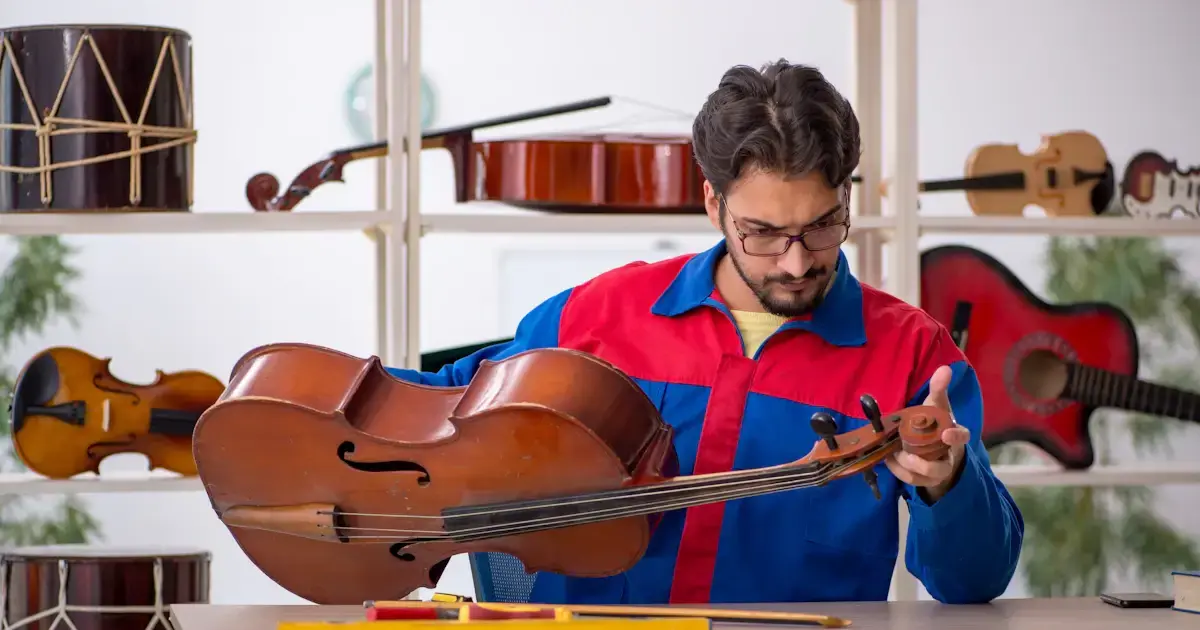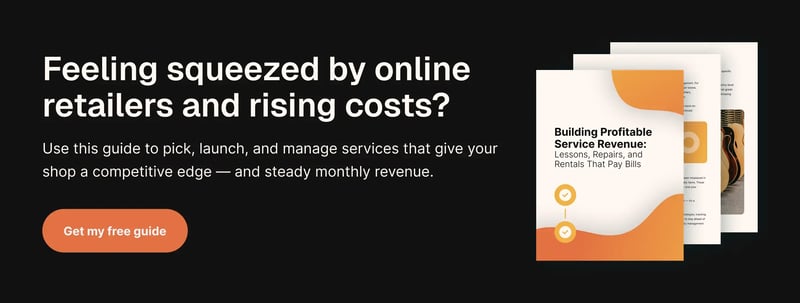
Does your music store offer consignment?
If not, you’re missing out on an easy opportunity to make money.
Musical instrument consignment is the process of selling someone else’s musical instrument at your store and charging them a commission. Offering consignment can be a great asset to a music business as it brings interesting and often unique musical instruments to your store without requiring you to purchase them.
In this blog, we’ll explain how musical instrument consignment works and discuss the most important steps in the process — including appraising an instrument, managing inventory, sales strategies, and more.
1. Understand the Benefits of Consignment
So, why sell instruments on consignment? For one, consignment presents minimal risk to music store owners. A consignor offers their musical instrument, and you offer store space, marketing, and sales services. But if an instrument doesn’t sell and an owner takes it back, there’s no direct financial consequence to you, only wasted store space, effort, and time.
Consignment items can increase customer interest in your music store, too. These used items might be rare or historically significant in the industry, drawing the eyes of musicians and music enthusiasts. Making consignment a consistent part of your business can draw in customers looking for something unexpected and add variety of your store’s offering.
Working with owners of valuable musical instruments also helps you create client relationships that benefit your business. If a customer has a good experience selling with you, they’re likely to come back when they have another instrument to sell — and to frequent your music store when looking for an instrument to buy. To nurture these relationships, be trustworthy and respectful to each seller you interact with.
2. Appraise the Instrument
To effectively sell a musical instrument on consignment, you need to appraise it. Setting strategic prices based on an item’s value helps you make a profit and benefits the seller.
Skill in appraising music items requires research and experience. As a music store owner, you likely already have a good understanding of how much different items are worth. Or maybe you’re new to the game. Either way, extensive research helps you get a sense of how much customers are willing to pay for an item. Over time, greater experience appraising and selling instruments sharpens your skills and improves your instincts.
Be sure to consider the following criteria as you appraise instruments:
- Brand
- Model
- Age
- Condition
- Maintenance history
All of these factors affect an instrument’s value. When an instrument comes in, ask the owner for all of this information and document it so you have everything on record as you make your appraisal. Do your research and if necessary, seek an outside appraisal opinion so you can set the right price for each item.
3. Build Consignor Relationships
To create beneficial relationships with consignors, you need to clearly explain your terms and stick to them. Make sure you’re both clear about what percentage you’ll take as commission, if there’s a certain amount of time you’ll keep the item on your shelves, and any other important information they might need. Changing the terms of the agreement causes consignors to lose trust in you.
The terms of a consignment agreement can be negotiated on a case-by-case basis. As you negotiate with a consignor, remember what you’re bringing to the table. They provide the instrument, while you provide a facility, exposure to customers, marketing, and sales. Consignors are willing to sacrifice the amount of your sales commission in return for these benefits, but be sure to set reasonable terms so they’ll want to sell with you again.
Another step you can take to encourage repeat business is to ask for feedback from the consignors you work with. Ask them for their opinions about the parts of the process that went well and if anything was difficult or frustrating. As you hear feedback and read reviews, think about what you can change to create a better experience for your customers.
Ultimately, the better you can sell instruments and work with consignors, the more consistent consignment work you’re likely to have.
Related Read: 7 Retail Customer Service Tips for Music Stores
4. Market Your Consigned Items
You can use similar methods to market consigned items as you do your other products, but make sure to emphasize their uniqueness and individuality. Display them prominently at the front of your music store, and consider including written information about an item as part of a display.
You can also use social media to market consigned pieces. Create posts and stories on platforms like Instagram and Facebook where you share images and videos of these items, as well as information about its model, history, and origin.
As digital advertising becomes more sophisticated, advertisers can more sharply target the people who are most likely to buy a product. You can post ads to sites like Google and YouTube and target those who are likely interested in music and instruments. Using a combination of in-person and digital advertising helps you get the word out to a wider audience, so you can sell instruments faster.
Related Read: 12 Fresh Ways To Amp Up Your Music Store Marketing
5. Sell Online
Selling instruments online expands your audience, and is an effective way to sell consignment items. You can sell on your business’ own website, or on external sites like Reverb or eBay.
Your website is most effective if it’s simple and easy to use. Include high-quality images of your products and detailed product descriptions. Make sure customers have a clear idea of what they’re buying. The same principles apply to consignment items, but make sure to clearly differentiate between individual consignment items and items that are part of your regular stock.
You can also sell on external websites. Reverb is a site designed for the sale of musical instruments. Anyone can list an item on the site, which has millions of visitors. eBay is another online option designed for general merchandise, including musical instruments.
Related Read: Online Music Instrument Store: 9 Simple Steps
6. Sell In-Store
Try to create a welcoming environment in your music store that encourages customers to browse. This includes clear and organized paths through the store, bright colors, and eye-catching product displays. Once customers make their way to the store, staff should engage with them. It’s a good practice to ask them some casual questions about what they’re looking for, but be careful not to pry too much.
As customers show interest in consignment items, discuss the significant features and value. Try to separate serious buyers from “tire-kickers,” named for customers who kick the tires of used cars, asking lots of questions but never making a purchase. Don’t spend too much time discussing an item with someone who seems unlikely to actually make a purchase.
You can also give a demo of the instrument to an interested person or let them demo it themselves. Getting to play the instrument themselves can speed them along the buying process.
7. Charge the Right Commission Rate
Consignors are willing to pay a music store a commission for the resources and effort they put towards selling an item — but finding the right commission rate is important, and a standard commission rate isn’t always the answer.
For musical instruments, commission rates are usually around 15–30%. However, the more valuable an item is, the lower the commission rate the consignor tends to accept. Being open to negotiating these rates allows you to work with more consignors by reaching agreements that are beneficial to both parties.
As you determine the rates you’ll offer for consignment, choose ones that allow you to make a profit while also fairly compensating the customer based on the value of their instrument.
Related Read: How Much Does a Music Store Owner Make? + How To Increase Sales
How To Offer Musical Instrument Consignment With Music Shop 360
Adding musical instrument consignment to your store’s offering is a low-risk way to bring unique and interesting musical instruments to your store and boost profits. As you plan and implement your consignment processes, remember to be trustworthy and respectful with consignors, set commission rates strategically, and use diverse marketing tactics.
As you do consignment, monitor which strategies are most effective and adjust them based on your customers. When you have a sense of which instruments your customers bring in and the commission rates they expect, you can help them make money while making a significant profit yourself.
To effectively offer consignment, you need a point of sale (POS) system. Music Shop 360 is an all-in-one POS solution that helps you manage all aspects of your music store. Designed with music stores in mind, Music Shop 360 has features to help you with consignment, including an integration with Reverb.
To see the difference Music Shop 360 can make for your music store, schedule a free demo today!




 by
by 



